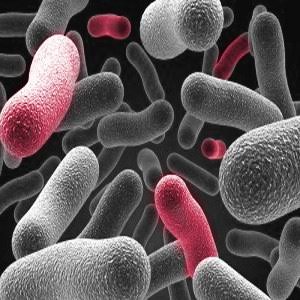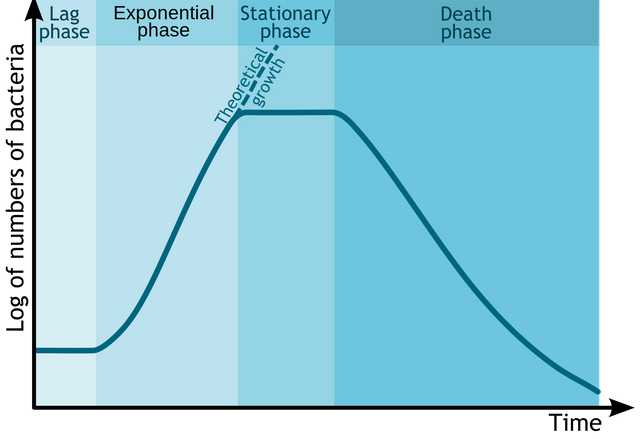Bacteria and Bacterial Growth
.jpeg)
bacteria, source : Flickr
Hi steemians,
In order to facilitate understanding of the biological characteristics of water and wastewater, it is needful to discuss the rudimentary principles of microbiology as it relates to water and wastewater treatment.
In this article i will concentrate more on characteristics of "bacteria and bacterial growth" which is one of the classification of microorganisms. In my subsequent articles i write on other classification of microorganisms.
So let's get started..
A lot of persons do not know that most supposed clean water contain bacteria. They are only aware of wastewater because of its colour or odour.
So one would ask. What is bacteria?
Simply put, Bacteria are unicellular plants varying in size from 0.5 to 3.0 microns, and without chlorophyll. They take in soluble food and convert it into new cells. Reproduction is by equally parted fission. Bacteria are sensitive to pH and temperature and prefer the neutral pH scale. However, some like sulphur bacteria can grow in very acidic conditions. Generally, there is an optimum temperature for the growth of each type. This will take us to the structure of bacteria.
Structure of Bacteria
Bacteria has a slime layer which is composed of polysaccharides; a cell wall which gives the bacteria rigidity and shape; and a cell membrane which acts as a barrier to the passage of large molecules in and out of the cell and controls the transfer of water and solutes.
The RNA aids in protein synthesis. The flagella are a structure for mobility present in some bacteria. The inner cell contains sugars, salts, vitamins, amino acids and coenzymes.
Bacteria are usually classified according to the temperature range under which they survive, their oxygen requirements and their shape.
With respect to temperature range of growth, they are classified as cryophilic (12-18°C), mesophilic (25-40°C), and thermophilic (55-65°C). With respect to oxygen use, they are grouped as aerobic if they require oxygen for respiration; anaerobic if they do not need and utilize oxygen for respiration; and facultative, if they can survive in the presence or absence of oxygen.
One would ask does bacteria have shape? What does it look like?
Yeah, they do have shape. They look spherical or Ovoid-shaped, rod shaped and curved or bent shaped .
The spherical or ovoid-shaped bacteria are called cocci. They are non-spore forming and non-mobile. They can occur singly (micrococus), in pairs (diplococus), in chains (streptococcus), irregular bunches (staphylococcus), and cubical pockets (sarcina).
The rod-shaped bacteria usually have whip-like structures called flagella which are for mobility. Some have spores which may be oval or spherical in shape; central, terminal or sub-terminal in location. The spores are dense, refractile structures which are highly resistant to heat, drying and chemical attack. The spores enable them to survive adverse conditions.
The curved or bent rod shaped bacteria are non-spore forming, mobile bacteria. Some have gelatinous covering for protection against adverse conditions.
How to Determine Bacteria Concentration
There are different methods of determining the concentration of bacteria in water and wastewater samples. The methods are plate count, total coliform MPN test, and membrane filter technique.
The plate count is a method that is used for determining the bacterial density of water. This test is useful for estimating the sanitary conditions of basin filters, distribution systems and sand treatment units. The test involves placing 1 my of water on a sterile Petroleum dish 100 mm in diameter. A sterile nutrient medium (10 my liquefied Plate Count Agar) is then added on the dish and the dish incubated at 20°C for 48 hrs (or 37°C for 24 hours). Each bacterium in water will form a visible colony at the end of the incubation period. The colonies are counted and the total count should not exceed 100 per litre for potable drinking water.
Another method is the total coliform MPN (Most Probable Number) test, which is purely a statistical estimation of the concentration of coliform organisms present in 100 mood the sample.
What is the meaning of Coliform organisms?
Coliform organisms comprise of all the aerobic, anaerobic, facultative, gram-negative, non-spore forming rod-shaped bacteria which ferment lactose with gas formation within 48 hrs at 35°C.
While the membrane filter technique involves filtration of water of water sample (100 ml) under vacuum through a sterile membrane filter. The filter pore diameter is small enough to completely retain coliform bacteria placed on a medium and incubated at 35°C for 24 hrs. After the 24 hours incubation the colonies that develop, exhibiting a metallic sheen are considered presumptive coliforms.
The membrane filtration method is very easy to perform and highly reproducible. Compared with the most probable number technique, the membrane filter technique yields results faster and with greater precision.
Bacterial Growth
The knowledge of the nature of bacterial growth is important in environmental control especially in the control of biological waste treatment. Reproduction in bacteria is by binary fission, sexual mode or by budding.
The stages of bacterial growth can be grouped into the lag phase, long (exponential or growth) phase, stationary phase, and log death phase.
The lag phase represents the time required for the organisms to acclimatize (i.e to get used to a new climate) to their new environment. Although enzymes and intermediate products are synthesized, detectable growth does not usually occur. The cells grow in size but not numerically. The lag period is dependent on the composition of the new medium relative to the old where the cells were formerly kept as well as duration of exposure to unfavorable conditions in the old medium.
The exponential phase is also called the log growth phase. During this phase, cells divide at a constant rate determined by their ability to process food and the time required for each fission. The relative amounts of enzymes, metabolites, and other constituents do not change in this phase. The log number of cells is directly proportional to time.
During the stationary phase, population remains static because cells have exhausted nutrients and death of old cells equals growth of new cells. Cells in this phase are smaller in size.
The death phase sets in after the stationary phase, resulting from depletion of cellular reserves of energy. The logarithm of the number of cells (log No) in this phase is negatively proportional to time.
Conclusion
Bacteria are found in almost every part of the world, and they grow in different conditions. Temperature, moisture, pH and environmental oxygen helps in the growth of bacteria. Bacteria is a tiny living organism, and they are made of carbohydrates, proteins, lipids, water and other elements.
When we understand the condition or environment where bacteria grows, it will help us to curtail the potential danger of bacterial infections or poisoning both in food and water.
References for Further Reading
[1] Bacteria
[2] Bacterial Growth
[3] Bacterial growth -Science direct
[4] Growth of Bacterial population
[5] Bacteria - Characteristics Of Bacteria, Bacterial Growth, Physical And Chemical Requirements For Bacterial Growth, The Role Of Bacteria In Fermentation - Aerobic and anaerobic bacteria
[6 ] Four conditions for bacterial growth
[7] Bacterial growth curve
[8] General Bacteriology


It looks like we have similar interests in water quality and environmental science. I look forward to following you and reading your future posts!
Yeah. Thanks for the feedback..
This post has been rewarded with 30% upvote from @indiaunited-bot account. We are happy to have you as one of the valuable member of the community.
If you would like to delegate to @IndiaUnited you can do so by clicking on the following links: 5SP, 10SP, 15SP, 20SP 25SP, 50SP, 100SP, 250SP. Be sure to leave at least 50SP undelegated on your account.
Please contribute to the community by upvoting this comment and posts made by @indiaunited.
This post has been upvoted and picked by Daily Picked #47! Thank you for the cool and quality content. Keep going!
Don’t forget I’m not a robot. I explore, read, upvote and share manually 😊
You can upvote, follow, resteem, delegate and join my curation tail to support me, good creators and minnows.
Thank you!
Hi @masterwriter!
Your post was upvoted by utopian.io in cooperation with steemstem - supporting knowledge, innovation and technological advancement on the Steem Blockchain.
Contribute to Open Source with utopian.io
Learn how to contribute on our website and join the new open source economy.
Want to chat? Join the Utopian Community on Discord https://discord.gg/h52nFrV